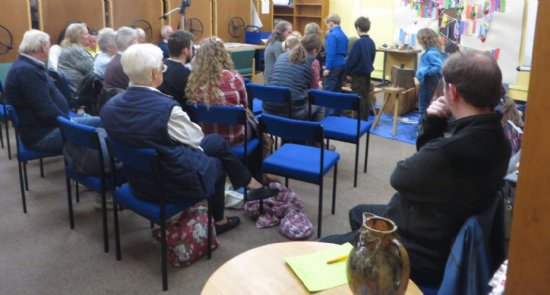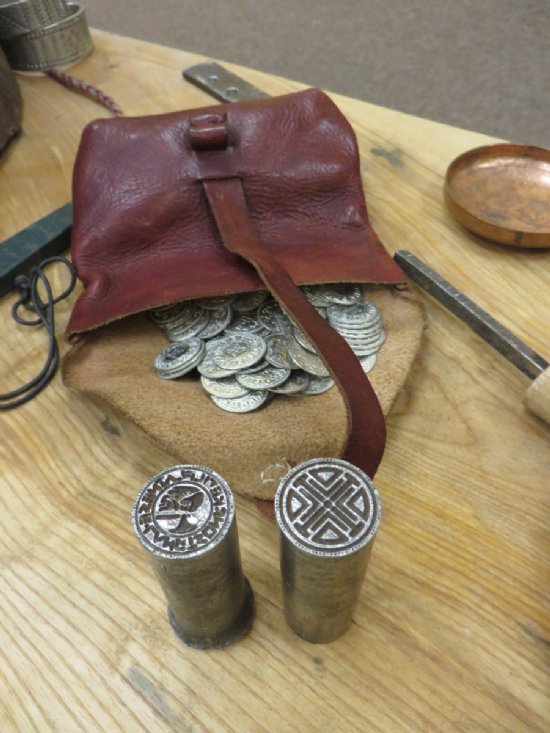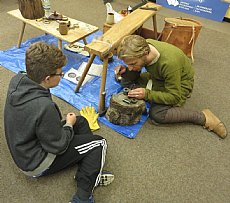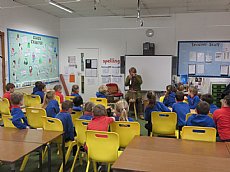Medieval Coinage Workshop
Posted by Susan Kruse - 13:07 on 17 September 2018
 The September Experimental Archaeology workshop had Stuart Strong, a historical interpreter and craftsman who led a session on medieval coinage for us at Inverness Library. He brought with him tools and raw materials to make replica coins – as well as some Viking replicas including a balance for weighing our coins.
The September Experimental Archaeology workshop had Stuart Strong, a historical interpreter and craftsman who led a session on medieval coinage for us at Inverness Library. He brought with him tools and raw materials to make replica coins – as well as some Viking replicas including a balance for weighing our coins.
The medieval period in the Highlands is a complicated time, and very different from southern Scotland. There were three main influences at work: Vikings from the north who controlled Caithness and Orkney, and at times even further south; the Lords of the Isles in the West (and occasionally the east) who were fairly autonomous until suppressed by the Scottish kings in the late 1400s, and the Scottish kings who gradually pushed their way northwards and eventually succeeded in bringing the area into the Scottish kingdom. The Inverness area was for much of this time a frontier zone.
 The Scottish kings brought new institutions and local rulers. David I (1124-53), who had spent his youth in England, introduced coinage. Before (and indeed after that) coins from other areas, particularly England, circulated in Scotland. However, no coins were minted in Inverness until Alexander III (1249-86) who minted coins widely over Scotland, in far more places than medieval Scottish kings before or after. After him, only James I (1406-37) minted coins in Inverness.
The Scottish kings brought new institutions and local rulers. David I (1124-53), who had spent his youth in England, introduced coinage. Before (and indeed after that) coins from other areas, particularly England, circulated in Scotland. However, no coins were minted in Inverness until Alexander III (1249-86) who minted coins widely over Scotland, in far more places than medieval Scottish kings before or after. After him, only James I (1406-37) minted coins in Inverness.
 Alexander minted a silver penny in Inverness, and the intent was to produce a replica of one of these coins in the workshop. However, the die was not ready, so we used another die – and pewter not silver. But in an interesting workshop, Stuart explained the whole process. First adequate supplies of silver must have been mined or melted down into ingots. These would have been hammered flat into sheets, and then blank round shapes cut out. Dies were then made in harder metal for the obverse and reverse part of the coin, with the design punched in using sets of punches. Finally the blank was placed between the two dies, and the coin hammered.
Alexander minted a silver penny in Inverness, and the intent was to produce a replica of one of these coins in the workshop. However, the die was not ready, so we used another die – and pewter not silver. But in an interesting workshop, Stuart explained the whole process. First adequate supplies of silver must have been mined or melted down into ingots. These would have been hammered flat into sheets, and then blank round shapes cut out. Dies were then made in harder metal for the obverse and reverse part of the coin, with the design punched in using sets of punches. Finally the blank was placed between the two dies, and the coin hammered.
 There was plenty of opportunity for people to try hammering their coin, and it proved especially popular with the children at the workshop and at a school visit the day before.
There was plenty of opportunity for people to try hammering their coin, and it proved especially popular with the children at the workshop and at a school visit the day before.
We speculated on where the mint might have been located in medieval Inverness. Stuart showed quite clearly that a mint need not have been a huge workshop area. However, the fact that it involved precious raw materials and then finished products would have led to security issues. The castle would be the likely place for the mint – but it would have required a forge as well as a workshop area.
Many of us were left wanting to find out more – about Alexander III, medieval Inverness and where coins minted in Inverness have been found throughout Scotland and England. Each would tell a story.
For the loans box, Stuart will be supplying a set of dies for the Alexander III coin and some coins struck from them.
Other Resources
Books (available in Inverness Library)
Bateson, Donald 1987. Scottish coins.
Bateson, Donald 1991. Coinage in Scotland.
Holmes, Nicholas 1998. Scottish coins: a history of small change in Scotland
J.D. Bateson and N.M. McQ. Holmes have periodically published surveys in Proceedings of the Society of Antiquaries of Scotland:
‘Roman and Medieval Coins found in Scotland 2016-10’ – v. 143 (2013), 227-263
‘Roman and Medieval Coins found in Scotland, 2001-2005’ – v. 136 (2006), 161-98
‘Roman and Medieval Coins found in Scotland, 1996-2000’ – v. 133 (2003), 245-76
‘Roman and Medieval Coins frond in Scotland, 1988-95’ – v. 127 (1997), 527-61
These are also available on-line http://archaeologydataservice.ac.uk/archives/view/psas/volumes.cfm
Images online
There are a number of images on-line, particularly from retailers selling coins.
The Portable Antiquities Scheme in England also has a number of Scottish coins illustrated.
SCRAN also illustrates a number of Scottish coins.
Videos
Hammered Coin manufacture
Dave Greenhalgh is featured here with Barrie Cook, curator of Medieval coins from the British Museum, making and discussing hammered coins.
5:35
Shaking Hands with the Past
Jorvik Group video showing how Viking coins were made
3:48
Websites
Scottish coinage – overview on Wikipedia
Mints of Scotland – overview on Wikipedia with chart of Scottish kings and where they minted coins
Making coins in the Middle Ages - Royal Mint Museum
Stuart Strong’s website www.gearandgraith.com
The Experimental Archaeology: Learning about technologies in the past project has been funded by Historic Environment Scotland and the Heritage Lottery Fund.
Add your comment below
- Recent Blog Articles
- Learning Resources
- Crafting Day October 2018
- Medieval Coinage Workshop
- Viking Ring-Money workshop
- Thomas Telford Workshop
- Monthly Blog Archive
- June 2018
- May 2018
- April 2018
- March 2018
- February 2018
- January 2018
- December 2017
- November 2017
